Lenovo Yoga 3 Pro Transformer Ultrabook: Intel Core M in Good Environment
When the first ultrabooks appeared, the companies seemed to compete with each other - who would rather copy the MacBook Air and not run into a lawsuit from Apple. Copying was subjected not only to the exterior, but also to the filling. Putting a number of motherboards, they could be confused, if not the characteristic color of the textolite in the "macbooks". But despite the obvious resemblance, Apple was stoically silent. Which rather thickly hinted at the existence of agreements with Intel, which released a special version of Core 2 for the first generation of MacBook Air, and invested a lot of money in creating an energy-efficient ultra-mobile platform. By all indications, Apple agreed that some of the developments will be available to other manufacturers in exchange for a two-year first night right.
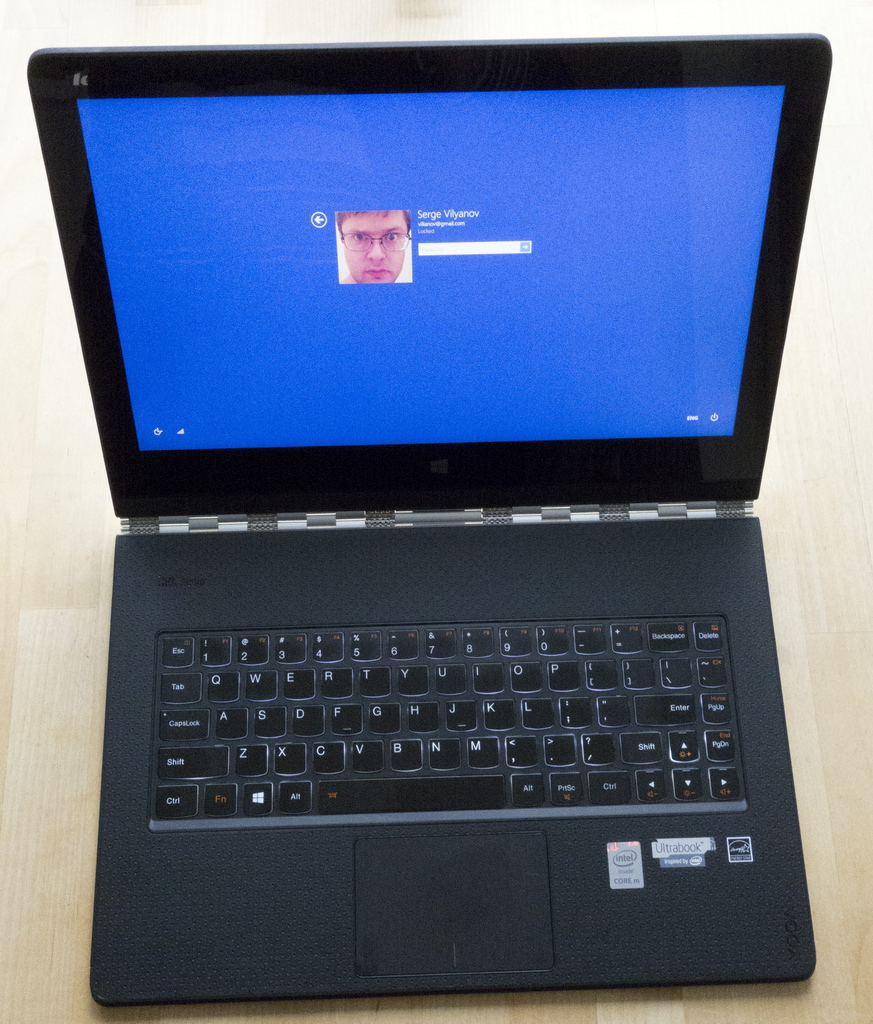
Some manufacturers are still inspired by the Air lines, but most still go their own way. Lenovo Yoga 3 Pro is a sample of a distinctive solution combining an unusual and complex for mass production form factor with good consumer qualities in a traditional laptop mode. Plus, at the time of the announcement in October 2014, it was the first serial product on the Intel Core M. platform. I waited a long time for the Yoga 3 Pro to be officially sold in Russia, but so far only small online stores carry it. Therefore, this text is prepared for the sample of the very very first batch, with an American plug and the lack of Cyrillic on the keyboard. Looking ahead, I’ll say that no serious flaws were found in it, although minor improvements could be made to the design during production.
')

The main intrigue of this model is the Intel Core M 5Y70 processor with a base frequency of 1.1 GHz and the ability to accelerate under load to 2.6 GHz. And all this in the framework of the thermal package (TDP) 4.5 watts. For comparison, the ultra-mobile version of the Core i5 Haswell family have a TDP of at least 15 watts. It would be a miracle if, with such parameters, the Core M processor would have the same or even better performance, but no. In the absolute majority of tasks, Core M is 15–20% slower than the Core i5 of the Haswell family, and only in some games it is on a par with it, thanks to an improved graphics core.

But you should not be upset. The performance margin is sufficient for most non-player tasks. And even if you are accustomed to open a lot of tabs in the browser and keep several “heavy” applications open, the processor will cope. I, at least, did not have a sense of inhibition of work compared to even the ultrabook on the Core i7. But on the other hand, state-of-the-art production technology (14 nm) and a compact thermal pack should, according to promises from Intel, provide impressive battery life.

Is it really? Yes and no. If we compare Yoga 3 Pro and Yoga 2 Pro (Intel Core M 5Y70 and Core i5-4200U, respectively), then both of them will work approximately the same - about 5 hours (this is, of course, full use, not just standing with the screen on) . But the Yoga 3 Pro is much less capacious battery (44 Wh-54 vs. 54 Wh-the old yoga). So, if the batteries had the same capacity, the Yoga 3 Pro would have worked about an hour longer. And even a half. Let’s leave Lenovo’s engineers and marketers to make the ultrabook as thin as possible. Weight 1.2 kg, thickness 12.8 mm is, of course, impressive. But while maintaining the weight of the Yoga 2 Pro (1.4 kg), it was possible to ensure autonomy in the region of 8-9 hours, and the risk of breaking the back of the user would remain very low ... In short, the usual if it were yes. Judging by the persistence with which the design of the technology is brought to the thickness of the razor blade, most of us are still willing to pay for these experiments. And if there is demand, there will be supply. By the way, if you take Yoga 3 Pro by one of the corners, the rest of the body will noticeably droop. No, it does not affect the strength of the structure and its durability, but the sight is funny.
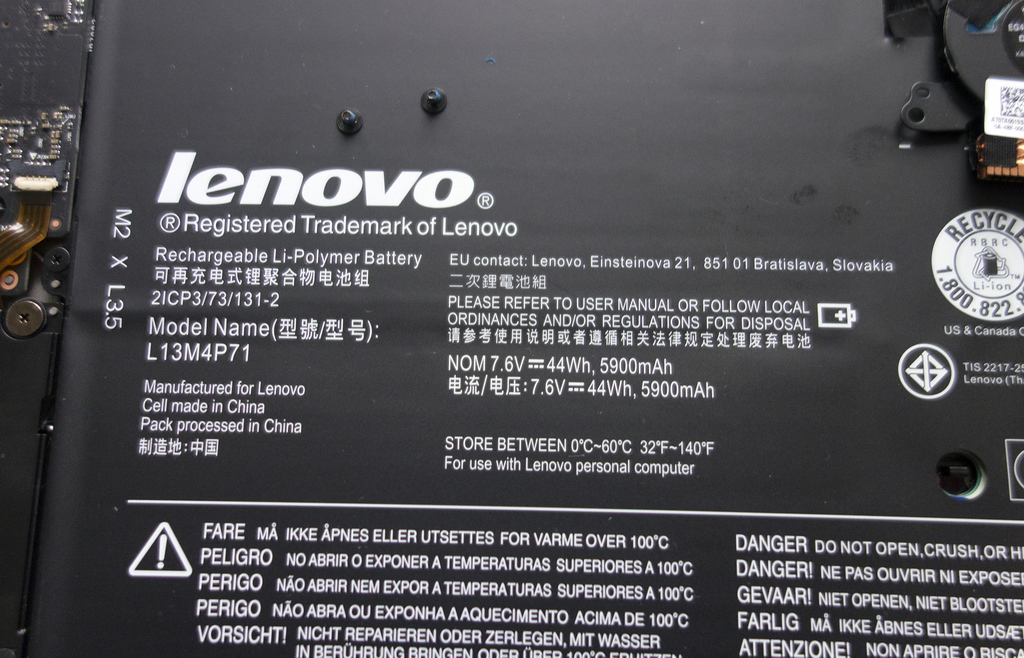
One of the main chips of Core M was the ability to work without active cooling. But in the Yoga 3 Pro cooler is. Small and so quiet that I did not hear it at first, but - there is. It works approximately 70% of the time, shutting down at a very low load. Probably, if the body was a bit thicker, it would be possible to limit the medium-sized radiator, but the latter simply did not fit into the elegant "Yoga".
The 13.3-inch matrix with a resolution of 3200x1800 seems to have migrated to the ultrabook from the previous model. Indeed, why improve the good? Uses IPS-screen with honest color and a solid margin of brightness. You can only find fault with uneven backlighting, noticeable on a dark background, but this may well be a feature of a particular instance. Yes, and do not notice during everyday use. From the purely technical side, there are no reasons for complexes with MacBooks with Retina screens, but you have to understand that a lot depends on application developers. If they have attended to the support of 3200x1800, everything will be beautiful and clear. If not, then at best, the image will be slightly blurred, and at worst, it will not fully fit into its window. In Windows 8.1 and especially Windows 10, the scaling mechanisms have noticeably improved, and yet don’t be surprised if your favorite application is unworthy of the Yoga 3 Pro screen.
I will clarify, just in case, that the screen is touch-sensitive, fulfills up to 10 clicks simultaneously. So, taking into account the diagonal of the ultrabook, you get a large full-fledged tablet on Windows 8. How much, of course, can a full-fledged tablet on Windows 8.
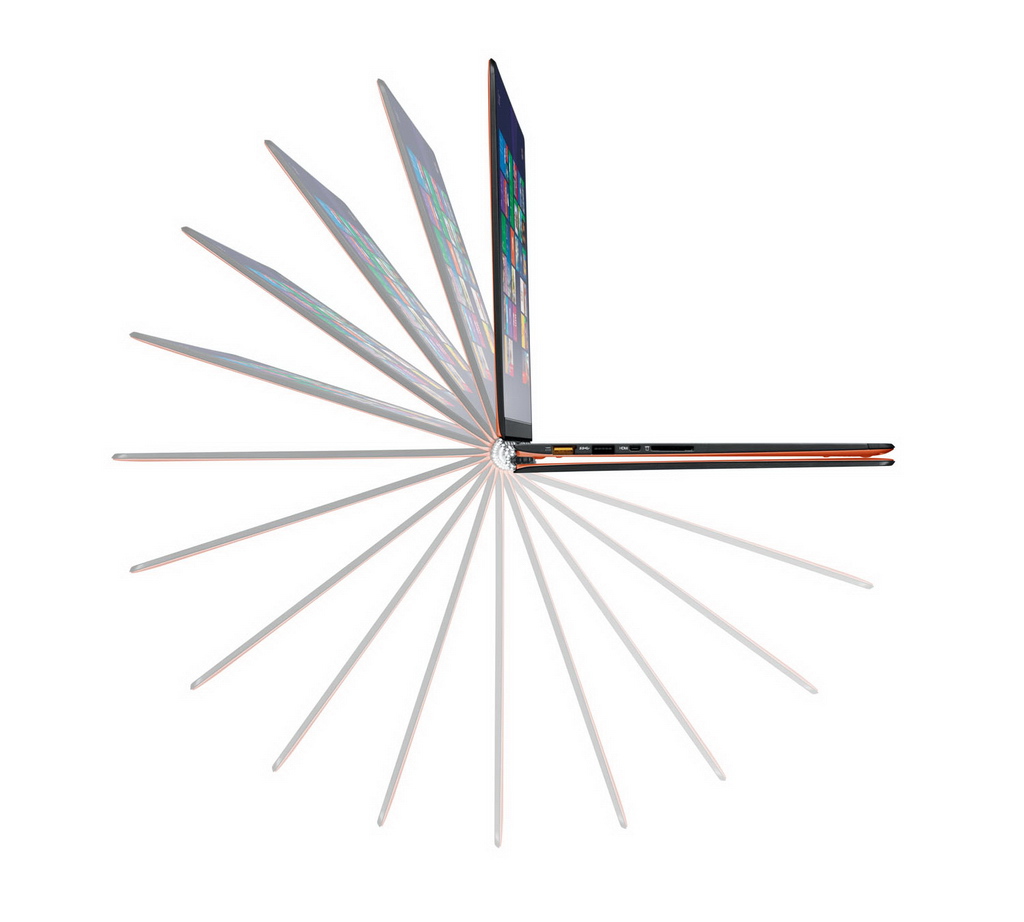
The top and bottom of the ultrabook is made of aluminum, and it pleasantly (or not, depending on the weather) cools the bare legs. Aluminum hinges are also made, on which the lid with the screen can open 180 degrees, turning the ultrabook into a large tablet. Between the loops proper, there are braided steel elements resembling metal watch bracelets. The composition looks good, but the decorative details noticeably thunder, evoking associations not with expensive watch brands, but with the grandfather's “Rocket”. However, I have nothing against “Rocket”. And against "Glory" too.
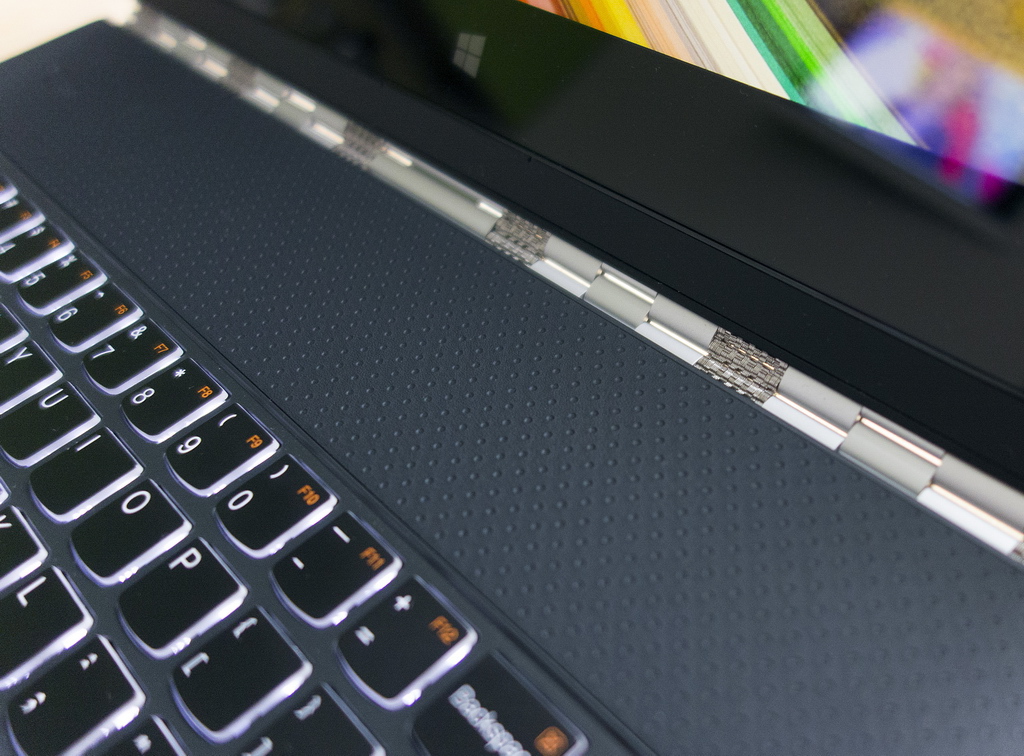

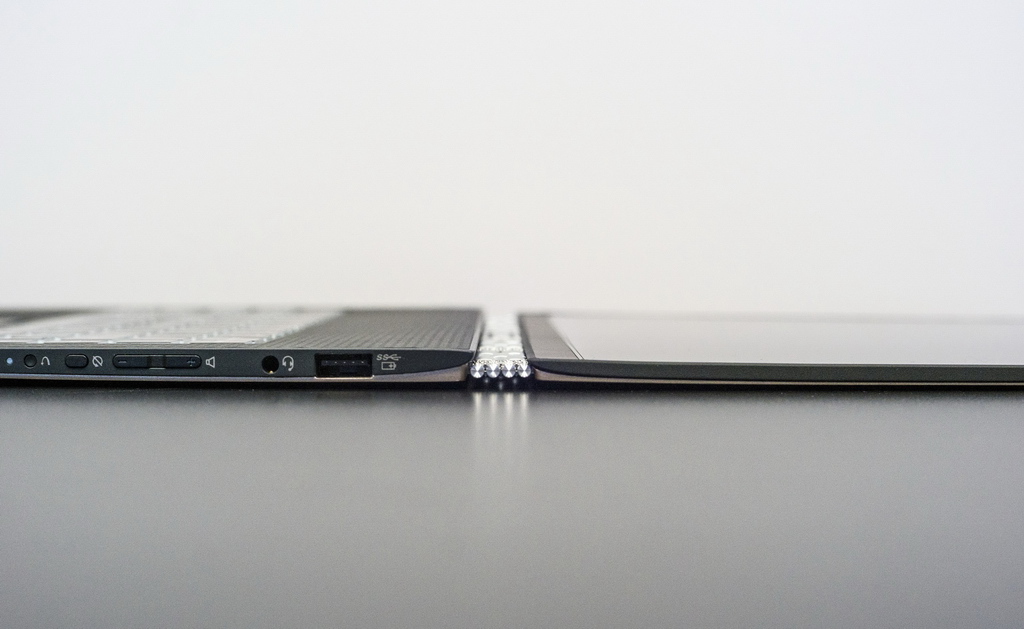
The surface around the keyboard is covered with plastic, pretending to be rubber. On the new device it looks and feels great, but during intensive use it can be slightly wiped, it has been observed more than once. I can’t say anything bad about the keyboard itself. Fingers lay, as it should, typing conveniently. There are lights. True, it does not have gradations of brightness, only “burns - does not burn”, but the level is set correctly, it suffices under any light conditions.
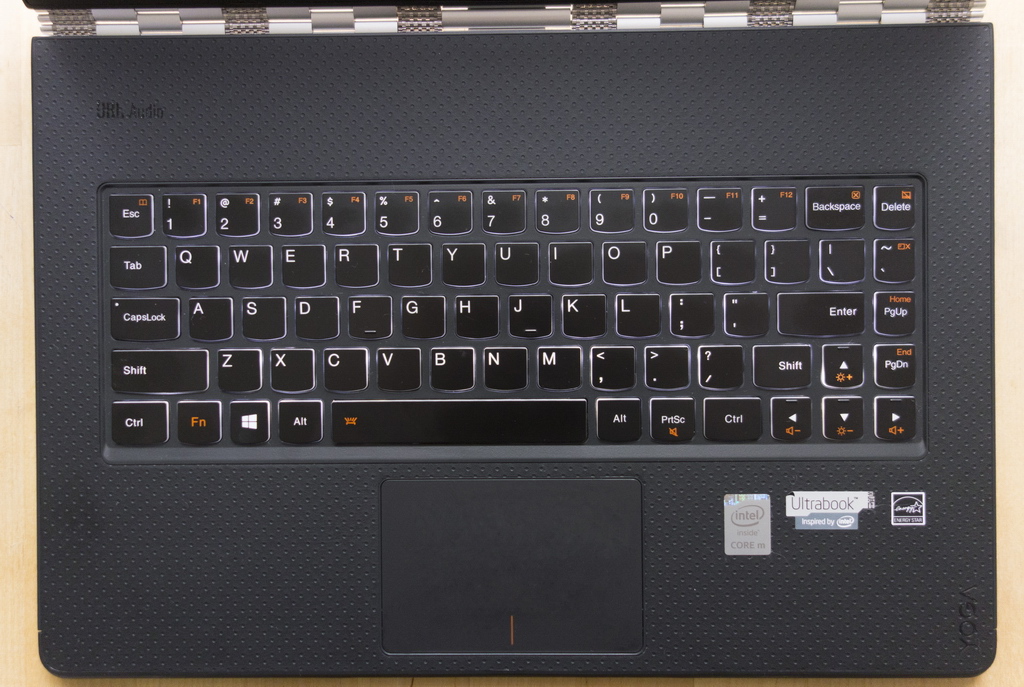
In a slim body, there lives a surprisingly loud sound branded by JBL Audio. The speakers themselves look quite usual for such a class of devices, but they were not overly economized on them, and they were provided with volume using software algorithms. Of course, on the Hi-Fi system, all this does not pull, but the sound stands out from the background of fellows. Especially impressive are the various effects in the films, the stereo base is really impressive.

I was also pleased that Lenovo did not release a version of the ultrabook with 4 GB of memory and 128 GB SSD. There is no sense from such weakness. The minimum configuration is 8 GB of RAM and 256 GB SSD. The latter can be taken more capacious, up to 512 GB. Plus, it is installed in the standard connector, so if after some time inexpensive models for a terabyte appear on the market, you can also install it. Although, of course, in the context of turns of the ruble exchange rate, “an inexpensive SSD” sounds like a mockery. But the memory is soldered on the board and can not be upgraded. Involuntarily, with longing, you will remember the first Lenovo Yoga, where there was a usual memory slot, and two more (!) Slots for SSD. Unfortunately, now this luxury is found only in very very expensive business models.
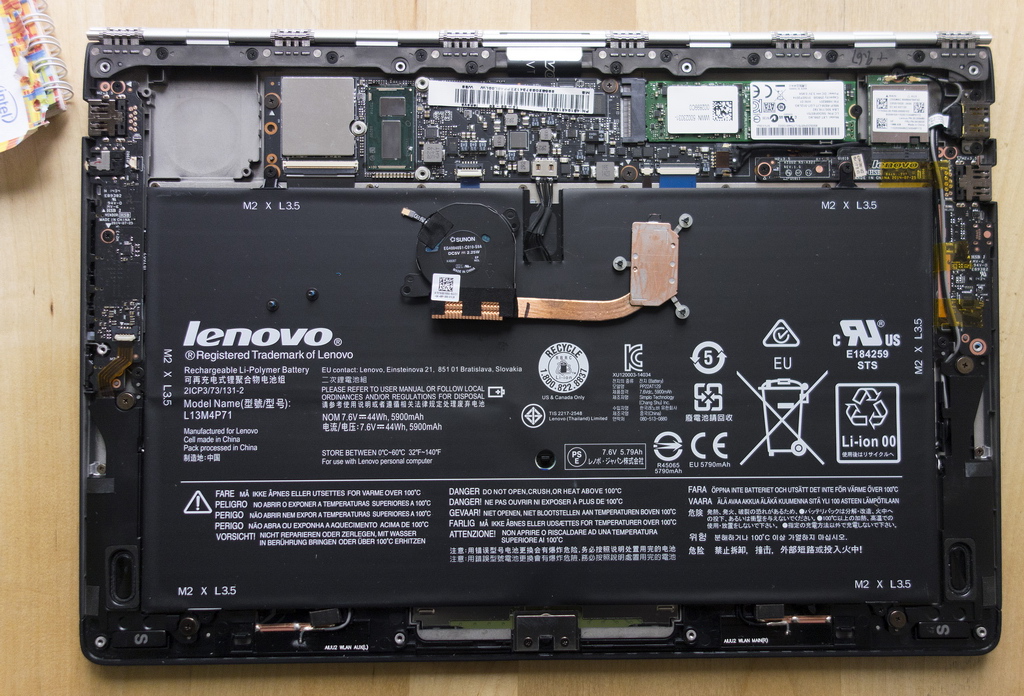
When you look inside the case, it seems that all the space in it is occupied by the battery. It is really huge in area, but this is “compensated” by a thickness of several millimeters. Electronics every year more and more similar to analogs in smartphones and tablets. It takes up very little space, but, unfortunately, and is subject to repair less and less. Only the replacement of large nodes. You can replace the SSD and Wi-Fi adapter, the latter, from Broadcom, is just very good. It connects with my router at a speed of 866 Mbit / s and keeps the connection flawlessly. I hope that a model with 802.11ac support will arrive in Russia, and not outdated 802.11n.
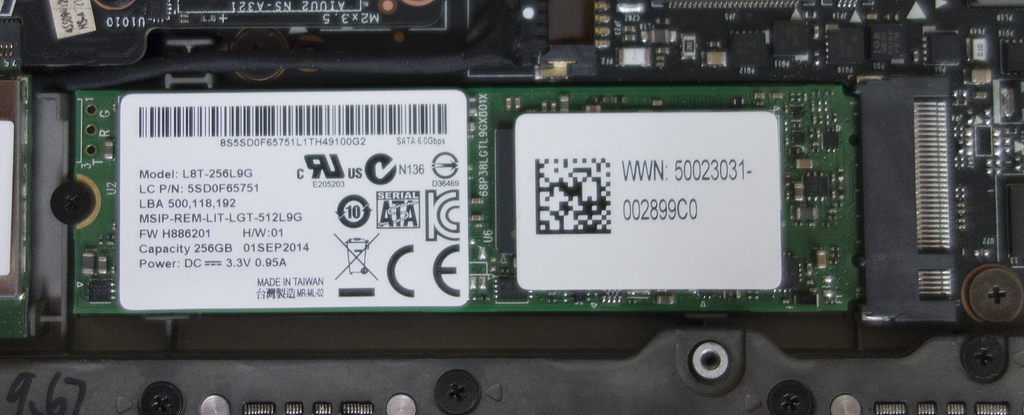

Given the thickness of Yoga 3 Pro, there is simply no room for a large number of connectors. However, we have two USB 3.0 ports (one can charge other devices when the ultrabook is turned off), one USB 2.0 cleverly combined with a charging connector, a card reader, micro-HDMI and a headphone jack.
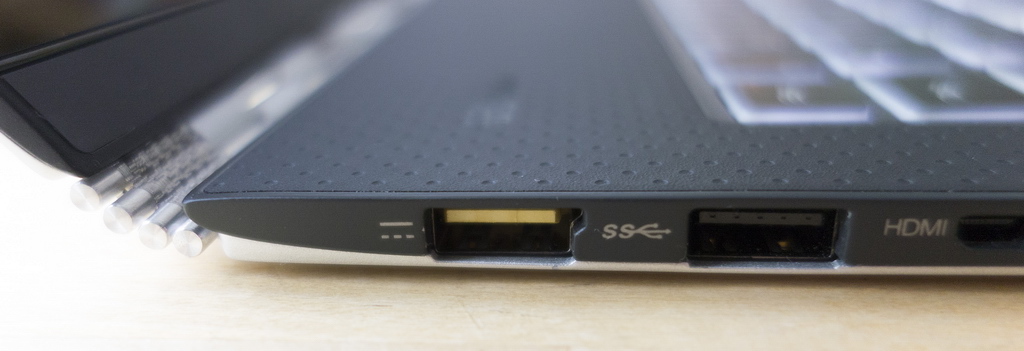

Also there was a place for two microphones, which provides high-quality voice communication even in noisy environments. In smartphones, this has long surprised no one (in expensive Lumia and build three of them), but not bad for an ultrabook.
And I was also very pleased with the charge. First, the cool combination of the USB port and the power supply — I've never seen anything like this before. A good place to save on board. Secondly, the charger itself looks quite decent and does not look like a standard elda, in which you need to insert a thick cable that came to us from a distant computer past. I began to fear that Apple had some kind of patent for normal-looking chargers. But no.
Total
When I first took Lenovo Yoga 3 Pro in my hands, it seemed somehow flimsy. I'm used to more brutal mobile computers - Lenovo ThinkPad, Acer TravelMate, MacBook Pro, finally. And then there is something thin, light ... Not serious.
But when he equipped the system and began using it at home for work and watching films, the attitude changed. Yes, the device is light and thin (easily lost among the papers and books on the table), but quite durable. Details do not fall off, scratches from nowhere do not appear. At the same time, despite the benchmarks, the responsiveness of the system is higher than that of the ThinkPad X1 Carbon on the 4th generation Core i5. Perhaps the effect is a larger cache (4 MB instead of 3).

Balanced machine. Everything in it is somehow in the mind, within reason. Personally, I would like from him only battery life for at least ten hours, so that, as in the case of the MacBook, I don’t pay attention to the charge level during the day. But given the compact and powerful charger, you can put up with the guaranteed five hours.
By the way, the ultrabook turned out also not very expensive. In the States, it costs $ 1,300 for the basic configuration (8/256 GB), and the top one, with Windows 8.1 Pro and SSD for 512 GB, will cost only $ 80 more. To these figures we must add another sales tax (about a hundred dollars), but still against the background of fellow with similar characteristics it turns out humanely.
In November last year, when Yoga 3 Pro was announced in Russia, they talked about the price "from 50 thousand rubles." The device has not yet reached the major networks, and the lowest price for a grayish copy in the online store is 83 thousand rubles. In one place drew a price tag of 110 thousand. Apparently, to hedge up for sure.
I assure you, the employees of Russian branches of IT companies grieve with you about the prices soared, but there are no miracles. And even if someone starts selling the equipment at a loss, they will immediately begin to arrive and fly in from neighboring countries, and the holiday will end quickly. It’s just that now you’ll have to take shopping much more seriously, wondering what it will be with them not even in a year, but in two or three.

By the way, Yoga 3 Pro with a more powerful Core M-5Y71 processor, which can overclock itself to the frequency of 2.9 GHz, with a slightly accelerated graphics core, will likely reach the official retail. Plus, unlike 5Y70, it has more flexible power settings. At least in the States all offers are already on it, and on the website Intel 5Y70 is listed as having been removed from sale.
I sincerely wish that your financial capabilities coincide with the needs even in our amazing time.

Some manufacturers are still inspired by the Air lines, but most still go their own way. Lenovo Yoga 3 Pro is a sample of a distinctive solution combining an unusual and complex for mass production form factor with good consumer qualities in a traditional laptop mode. Plus, at the time of the announcement in October 2014, it was the first serial product on the Intel Core M. platform. I waited a long time for the Yoga 3 Pro to be officially sold in Russia, but so far only small online stores carry it. Therefore, this text is prepared for the sample of the very very first batch, with an American plug and the lack of Cyrillic on the keyboard. Looking ahead, I’ll say that no serious flaws were found in it, although minor improvements could be made to the design during production.
')

The main intrigue of this model is the Intel Core M 5Y70 processor with a base frequency of 1.1 GHz and the ability to accelerate under load to 2.6 GHz. And all this in the framework of the thermal package (TDP) 4.5 watts. For comparison, the ultra-mobile version of the Core i5 Haswell family have a TDP of at least 15 watts. It would be a miracle if, with such parameters, the Core M processor would have the same or even better performance, but no. In the absolute majority of tasks, Core M is 15–20% slower than the Core i5 of the Haswell family, and only in some games it is on a par with it, thanks to an improved graphics core.

But you should not be upset. The performance margin is sufficient for most non-player tasks. And even if you are accustomed to open a lot of tabs in the browser and keep several “heavy” applications open, the processor will cope. I, at least, did not have a sense of inhibition of work compared to even the ultrabook on the Core i7. But on the other hand, state-of-the-art production technology (14 nm) and a compact thermal pack should, according to promises from Intel, provide impressive battery life.
Is it really? Yes and no. If we compare Yoga 3 Pro and Yoga 2 Pro (Intel Core M 5Y70 and Core i5-4200U, respectively), then both of them will work approximately the same - about 5 hours (this is, of course, full use, not just standing with the screen on) . But the Yoga 3 Pro is much less capacious battery (44 Wh-54 vs. 54 Wh-the old yoga). So, if the batteries had the same capacity, the Yoga 3 Pro would have worked about an hour longer. And even a half. Let’s leave Lenovo’s engineers and marketers to make the ultrabook as thin as possible. Weight 1.2 kg, thickness 12.8 mm is, of course, impressive. But while maintaining the weight of the Yoga 2 Pro (1.4 kg), it was possible to ensure autonomy in the region of 8-9 hours, and the risk of breaking the back of the user would remain very low ... In short, the usual if it were yes. Judging by the persistence with which the design of the technology is brought to the thickness of the razor blade, most of us are still willing to pay for these experiments. And if there is demand, there will be supply. By the way, if you take Yoga 3 Pro by one of the corners, the rest of the body will noticeably droop. No, it does not affect the strength of the structure and its durability, but the sight is funny.

One of the main chips of Core M was the ability to work without active cooling. But in the Yoga 3 Pro cooler is. Small and so quiet that I did not hear it at first, but - there is. It works approximately 70% of the time, shutting down at a very low load. Probably, if the body was a bit thicker, it would be possible to limit the medium-sized radiator, but the latter simply did not fit into the elegant "Yoga".
The 13.3-inch matrix with a resolution of 3200x1800 seems to have migrated to the ultrabook from the previous model. Indeed, why improve the good? Uses IPS-screen with honest color and a solid margin of brightness. You can only find fault with uneven backlighting, noticeable on a dark background, but this may well be a feature of a particular instance. Yes, and do not notice during everyday use. From the purely technical side, there are no reasons for complexes with MacBooks with Retina screens, but you have to understand that a lot depends on application developers. If they have attended to the support of 3200x1800, everything will be beautiful and clear. If not, then at best, the image will be slightly blurred, and at worst, it will not fully fit into its window. In Windows 8.1 and especially Windows 10, the scaling mechanisms have noticeably improved, and yet don’t be surprised if your favorite application is unworthy of the Yoga 3 Pro screen.
I will clarify, just in case, that the screen is touch-sensitive, fulfills up to 10 clicks simultaneously. So, taking into account the diagonal of the ultrabook, you get a large full-fledged tablet on Windows 8. How much, of course, can a full-fledged tablet on Windows 8.

The top and bottom of the ultrabook is made of aluminum, and it pleasantly (or not, depending on the weather) cools the bare legs. Aluminum hinges are also made, on which the lid with the screen can open 180 degrees, turning the ultrabook into a large tablet. Between the loops proper, there are braided steel elements resembling metal watch bracelets. The composition looks good, but the decorative details noticeably thunder, evoking associations not with expensive watch brands, but with the grandfather's “Rocket”. However, I have nothing against “Rocket”. And against "Glory" too.



The surface around the keyboard is covered with plastic, pretending to be rubber. On the new device it looks and feels great, but during intensive use it can be slightly wiped, it has been observed more than once. I can’t say anything bad about the keyboard itself. Fingers lay, as it should, typing conveniently. There are lights. True, it does not have gradations of brightness, only “burns - does not burn”, but the level is set correctly, it suffices under any light conditions.

In a slim body, there lives a surprisingly loud sound branded by JBL Audio. The speakers themselves look quite usual for such a class of devices, but they were not overly economized on them, and they were provided with volume using software algorithms. Of course, on the Hi-Fi system, all this does not pull, but the sound stands out from the background of fellows. Especially impressive are the various effects in the films, the stereo base is really impressive.

I was also pleased that Lenovo did not release a version of the ultrabook with 4 GB of memory and 128 GB SSD. There is no sense from such weakness. The minimum configuration is 8 GB of RAM and 256 GB SSD. The latter can be taken more capacious, up to 512 GB. Plus, it is installed in the standard connector, so if after some time inexpensive models for a terabyte appear on the market, you can also install it. Although, of course, in the context of turns of the ruble exchange rate, “an inexpensive SSD” sounds like a mockery. But the memory is soldered on the board and can not be upgraded. Involuntarily, with longing, you will remember the first Lenovo Yoga, where there was a usual memory slot, and two more (!) Slots for SSD. Unfortunately, now this luxury is found only in very very expensive business models.

When you look inside the case, it seems that all the space in it is occupied by the battery. It is really huge in area, but this is “compensated” by a thickness of several millimeters. Electronics every year more and more similar to analogs in smartphones and tablets. It takes up very little space, but, unfortunately, and is subject to repair less and less. Only the replacement of large nodes. You can replace the SSD and Wi-Fi adapter, the latter, from Broadcom, is just very good. It connects with my router at a speed of 866 Mbit / s and keeps the connection flawlessly. I hope that a model with 802.11ac support will arrive in Russia, and not outdated 802.11n.


Given the thickness of Yoga 3 Pro, there is simply no room for a large number of connectors. However, we have two USB 3.0 ports (one can charge other devices when the ultrabook is turned off), one USB 2.0 cleverly combined with a charging connector, a card reader, micro-HDMI and a headphone jack.


Also there was a place for two microphones, which provides high-quality voice communication even in noisy environments. In smartphones, this has long surprised no one (in expensive Lumia and build three of them), but not bad for an ultrabook.
And I was also very pleased with the charge. First, the cool combination of the USB port and the power supply — I've never seen anything like this before. A good place to save on board. Secondly, the charger itself looks quite decent and does not look like a standard elda, in which you need to insert a thick cable that came to us from a distant computer past. I began to fear that Apple had some kind of patent for normal-looking chargers. But no.
Total
When I first took Lenovo Yoga 3 Pro in my hands, it seemed somehow flimsy. I'm used to more brutal mobile computers - Lenovo ThinkPad, Acer TravelMate, MacBook Pro, finally. And then there is something thin, light ... Not serious.
But when he equipped the system and began using it at home for work and watching films, the attitude changed. Yes, the device is light and thin (easily lost among the papers and books on the table), but quite durable. Details do not fall off, scratches from nowhere do not appear. At the same time, despite the benchmarks, the responsiveness of the system is higher than that of the ThinkPad X1 Carbon on the 4th generation Core i5. Perhaps the effect is a larger cache (4 MB instead of 3).

Balanced machine. Everything in it is somehow in the mind, within reason. Personally, I would like from him only battery life for at least ten hours, so that, as in the case of the MacBook, I don’t pay attention to the charge level during the day. But given the compact and powerful charger, you can put up with the guaranteed five hours.
By the way, the ultrabook turned out also not very expensive. In the States, it costs $ 1,300 for the basic configuration (8/256 GB), and the top one, with Windows 8.1 Pro and SSD for 512 GB, will cost only $ 80 more. To these figures we must add another sales tax (about a hundred dollars), but still against the background of fellow with similar characteristics it turns out humanely.
In November last year, when Yoga 3 Pro was announced in Russia, they talked about the price "from 50 thousand rubles." The device has not yet reached the major networks, and the lowest price for a grayish copy in the online store is 83 thousand rubles. In one place drew a price tag of 110 thousand. Apparently, to hedge up for sure.
I assure you, the employees of Russian branches of IT companies grieve with you about the prices soared, but there are no miracles. And even if someone starts selling the equipment at a loss, they will immediately begin to arrive and fly in from neighboring countries, and the holiday will end quickly. It’s just that now you’ll have to take shopping much more seriously, wondering what it will be with them not even in a year, but in two or three.

By the way, Yoga 3 Pro with a more powerful Core M-5Y71 processor, which can overclock itself to the frequency of 2.9 GHz, with a slightly accelerated graphics core, will likely reach the official retail. Plus, unlike 5Y70, it has more flexible power settings. At least in the States all offers are already on it, and on the website Intel 5Y70 is listed as having been removed from sale.
I sincerely wish that your financial capabilities coincide with the needs even in our amazing time.
Source: https://habr.com/ru/post/376215/
All Articles